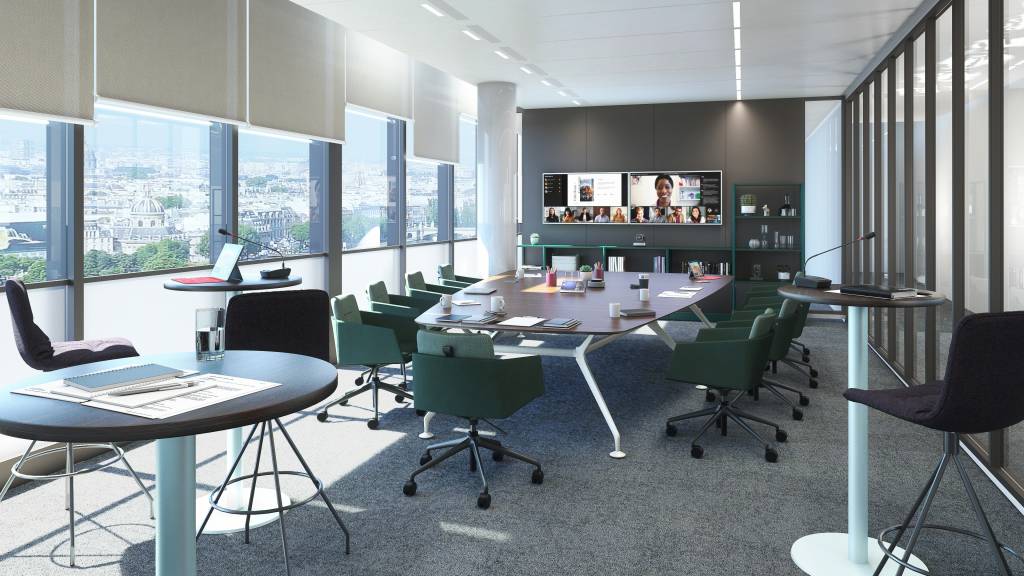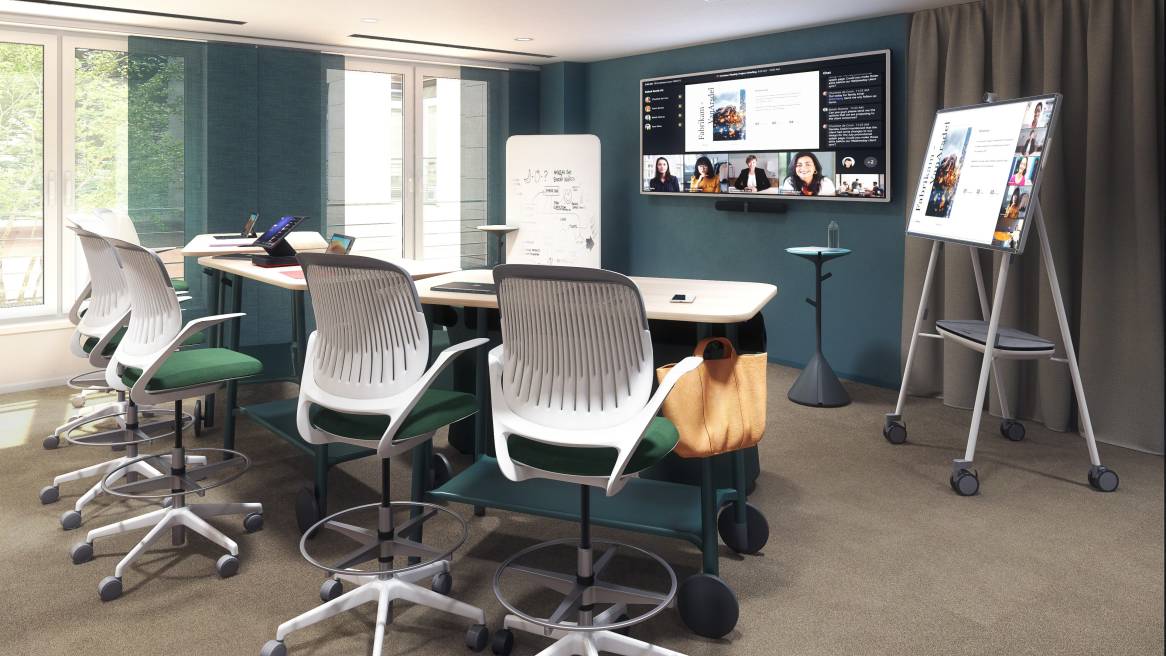Microsoft and Steelcase:
Pioneering Hybrid Together
Industry leaders join forces to create high-performance spaces optimized for hybrid.
Steelcase and Microsoft have been partners since 2017. The industry-leading experts in technology and the workplace have a shared mission to co-create spaces that help teams and individuals work better. Now, in France, Steelcase and Microsoft are collaborating to create the best hybrid collaboration spaces for organizations, teams, and individuals.
Today, hybrid meetings – where some people are in the office and others are remote – are the most common type of connections at work. Yet, according to Steelcase global research, people find hybrid collaboration spaces uncomfortable across the board. They cite spaces that are too small, distracting and lack the right visual and audio technology.
Great hybrid collaboration experiences address three key facets of the employee experience: equity, engagement, and ease. Successful hybrid collaboration is inclusive of people on both sides of the camera, empowers people to participate, and is intuitive to navigate.
Steelcase and Microsoft are developing a range of spaces and technologies to support a variety of hybrid collaboration experiences – informative (presenting and sharing information), evaluative (feedback and evaluation) and generative (brainstorming and problem solving). Here are four spaces designed for different team sizes and types of work.

3 to 5 people
This closed space has been designed to facilitate hybrid collaboration in an informal atmosphere. The lounge seats recreate the comfort of your living room and promote a relaxed atmosphere that invites everyone to speak. As a result, exchanges between users are dynamic and organic, which stimulates creativity. The all-in-one collaboration bar designed for Microsoft Teams ensures that everyone feels included. The quality of the sound and the positioning of the camera under the screen mean that everyone can see and be seen; hear and be heard. Featuring a simple and elegant design, the 8-inch touchscreen in the center of the table allows everyone physically present in the room to easily interact and control the Teams meeting.

5 to 7 people
This space offers teams what they need for hybrid collaboration, with modular furniture and digital and physical collaboration tools. The flexible space adapts to the desired experience, with versatile furniture and technology solutions. The semi-circular arrangement of Steelcase Flex Single Tables improves visual contact on both sides of the screen, enhancing the quality of interaction.
An AI-powered whiteboard camera compatible with Microsoft Teams Rooms facilitates hybrid creativity sessions and ensures active participation of remote collaborators. Truchet acoustic tiles arranged all around the screen enhance the acoustic comfort of the space.

8 to 12 people
This more formal space, ideal for informative collaboration, offers an optimized meeting experience. A variety of seating options allows users to move from a comfortable traditional position to a more dynamic posture.
The trapezoidal shape of the Orangebox table structures the space and improves the visibility of the participants on both sides of the screen. Several other elements promote the fairness of hybrid collaboration.
With auto-framing, speaker-tracking, and presenter-tracking features, the smart camera delivers a smooth face-to-face video experience. The smart speaker placed in the center of the table, with an array of 10 built-in MEMS microphones, provides a full-duplex HD audio experience and eliminates acoustic echo. The touch pad on the table makes it easy to control the display on the two screens. This configuration also allows you to have an extended view of all online participants and shared content in the Teams meeting.
Plus, the high furniture at the back of the room allows those present to stand back to take notes or for additional participants to join the group during the meeting.

This open, modular space equipped with the latest technologies is conducive to teamwork. This space is designed to adapt to all your meeting, including formal presentations, team meetings or collaboration between work groups.
All elements are flexible. This open environment lends itself ideally to two main types of configurations. It is possible to create a conference room that can accommodate 10 to 45 people face-to-face, to which are added the participants connected virtually on Teams from the two Surface Hubs. Or it is possible to create two separate spaces suitable for different types of collaboration.
Users can alternate between seated, standing, lounge or perched positions thanks to the presence of stools, ottomans and sofas. Individual tables paired with lounge furniture make it easy to use laptops, while high Steelcase Flex tables, complete with hooks, allow individuals to sit and hang their belongings.
Behind the panels, you can modulate a collaborative space. A wide screen, combined with a Microsoft Teams room and a 4K smart video conferencing bar fixed under the screen, facilitates an immersive and inclusive experience – a great way to break down barriers between in-person and remote employees. Surface Hubs on mobile Steelcase Roam carts allow participants to engage in brainstorming and collaboration sessions intuitively and autonomously.
Hybrid Is the Future
These high-performance spaces are examples of a vast array of hybrid collaboration environments that people need to do their best work. Together, Steelcase and Microsoft are dedicated to designing and engineering hybrid solutions that feature an unprecedented level of compatibility between space and technology. The goal is to optimize hybrid collaboration so that individuals and teams can successfully engage in dynamic sessions that drive forward progress and innovation. To experience some of these hybrid collaboration spaces in person, reach out to welcomep@steelcase.com to plan your visit to the Steelcase Paris WorkLife!


